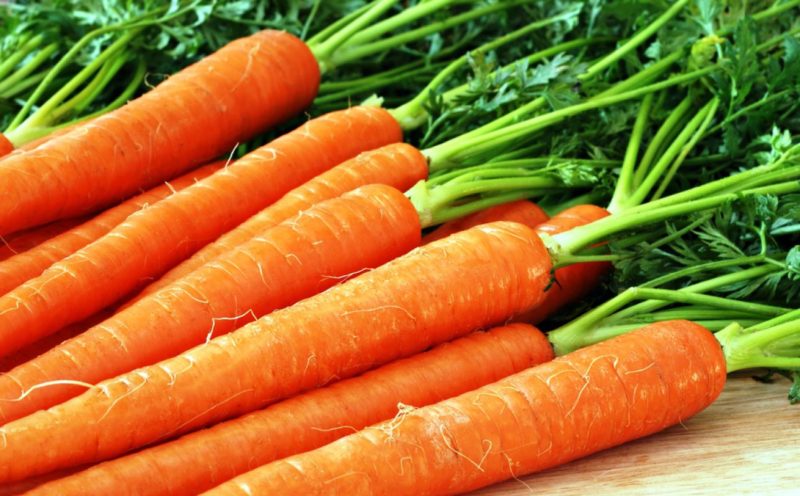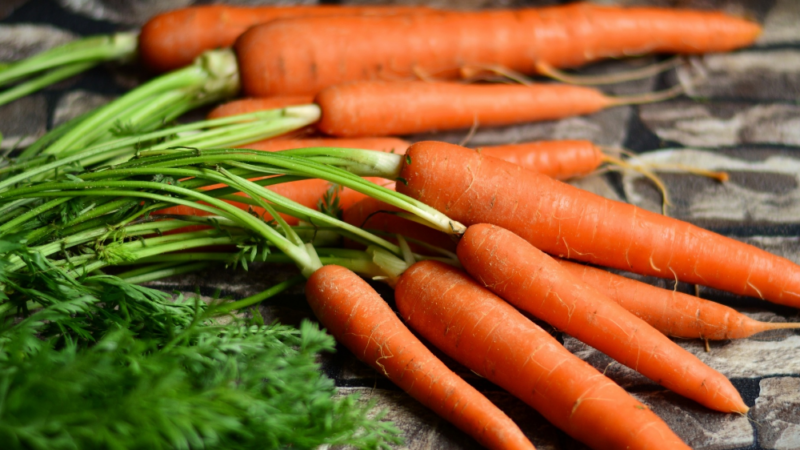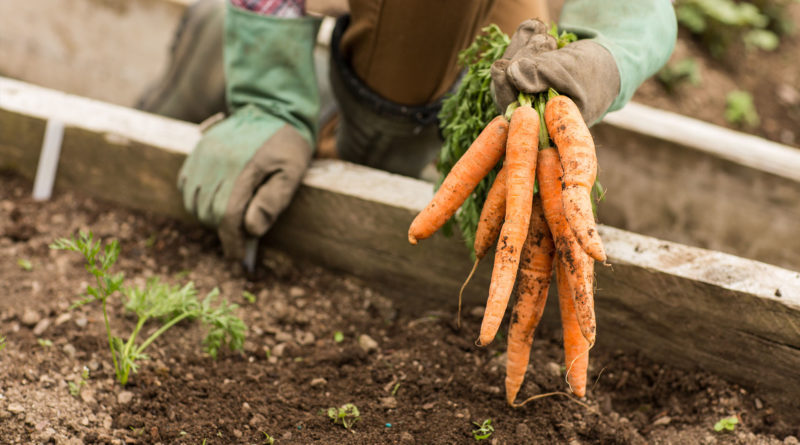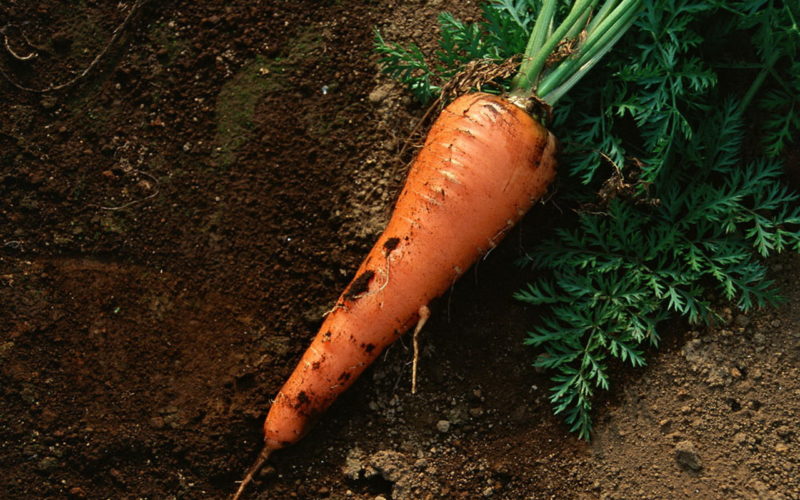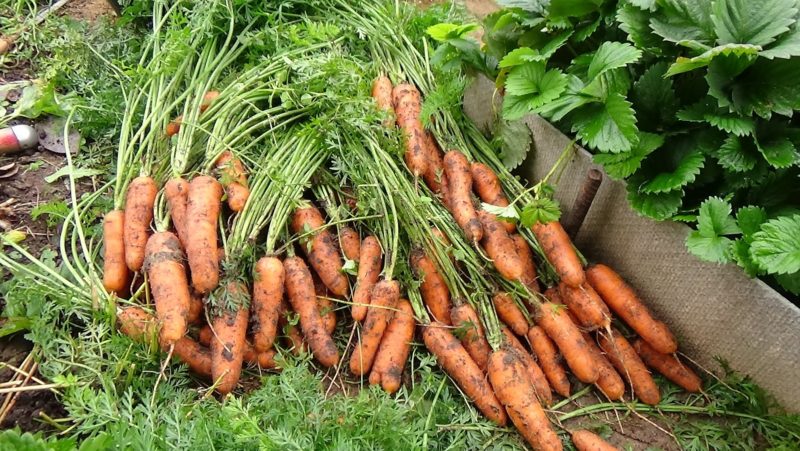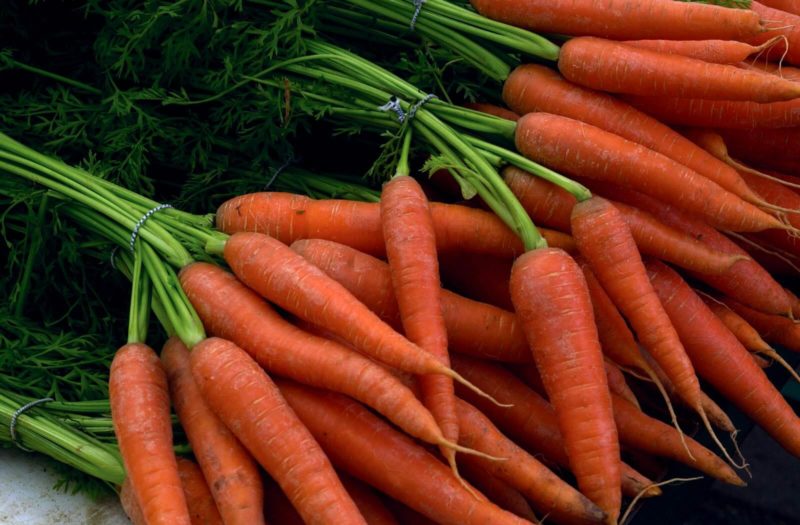This garden culture has long occupied high positions in terms of consumption among Russians. Despite the complexity of its cultivation, planting carrots and caring in the open ground is practiced by almost every summer resident. Consider how to avoid mistakes and achieve a rich harvest.
Material Content:
Variety variety of carrots
There are two types of carrots:
- sowing;
- wild.
These groups, in turn, are divided into subspecies. Sowing includes feed and dining.
The most popular varieties:
- "Alyonka." It differs in early ripening. The root crop itself is relatively small.
- "Tushon." Shoots appear early. Size is average.
- "Nantes." Ripening is fast enough. Root crops are large, suitable for long storage.
- "Vitamin". Middle ripening. This variety is notable for a large number of vitamins and high palatability.
- "Queen of the fall." Ripening is identical to vitamin. More than other types suitable for long-term storage.
- Flacca. High survival and the same yield. One of the favorite varieties that are often planted in the suburbs.
- "Moe." Shoots appear late. But the root vegetable is worth it: large and very juicy.
Choosing the appropriate type of vegetable culture, you should familiarize yourself with the main conditions for its successful breeding.
What you need to know to grow a rich harvest
You can get a large number of large and healthy root crops even on a small plot of land.If you combine the implementation of the main laws of agricultural technology with the recommendations of experienced gardeners, it is possible to achieve a good harvest, while maintaining their own strength.
The first step should be to determine the timing of sowing, depending on the variety.
Planting carrots in the spring begins in mid-April and lasts until mid-May. In early summer, you can safely collect mature root crops.
Summer sowing takes place already in early May, but with the condition of a sufficiently warmed up land. It is produced until the first summer days in June. And you can enjoy the sweet harvest before collecting the main garden crops.
Carrots are planted in autumn and winter from mid-October to mid-November. The most important when sowing is the correct location of the beds. They must be above the ground level so that snow melt does not spoil the seeds.
If you sow different varieties in compliance with all deadlines, the vegetable will be on the table year-round. But among the methods presented, the third option is most beneficial, since in this case the fruits will not be damaged by harmful insects.
The next step towards a rich harvest is choosing the right place.
When forming the beds, it is important to consider the main points:
- The presence of intense light.
- Loamy-sandy type of soil.
- Growing on the land of high-yielding crops, for example, tomatoes in the previous season.
Do not use beds on which dill or parsley grew last year. It is also not recommended to plant carrots twice in a row in the same place.
Large fruits grow especially well in peat obtained after drying of the marshland. And in clay soil, a culture can get an ugly form due to a powerful counteraction to growth.
Before the onset of cold weather, beds should be dug up, removing rhizomes and stones from them. However, there is no need to dig the soil too hard, making the landing site deep. Otherwise, the ground may freeze.
Sowing seeds in open ground
The landing dates have no strict restrictions. If a vegetable is grown as a vitamin supplement to dishes, then you need to plant it early. Usually sown in the ground, warmed up to + 5 ° C, to a shallow depth, reaching 3 cm. As mentioned earlier, the best option is autumn sowing, as a result of which carrots grow in more favorable conditions.
In cool weather, the seeds undergo adaptation to seasonal changes in temperature. And when harvesting, indicators several times overtake spring crops. However, this method has one drawback - it is impossible to further store root crops. Vegetable should be eaten immediately or dried.
In the spring, sowing is carried out immediately after the disappearance of the snow cover. The earth in this case is very wet, which is good for growth. If root crops will be stored throughout the winter period, then it is necessary to plant in the last May dates.
Of course, these tips are very relative. It all depends on the weather.
Carrots are very demanding on the quality of the soil. Fertilize it should be according to the growing season, or preparing the soil right before planting. These two methods are almost identical in effectiveness. You need to choose from them according to the type of fertilizer that will be used in the future. If organic fertilizers are present, they must be applied before planting. A serving is 1.5 - 2 kg per cubic meter. In clay soils, sand is added to improve texture.
Seeds need pre-treatment. They must be placed in warm water and held for such a whole day. After - soak for a couple of days in a cool place. You can also, putting them in a thin cloth, dip several times in hot water. This will improve the condition of the grains and protect against diseases.
It is better to plant in moist soil. If there was no precipitation, the beds should be abundantly watered, and the next day the soil should be loosened.
Then you need to follow a certain technique:
- Make a pair of furrows on each bed. The distance between them should be at least 20 cm.
- Sow seeds in furrows in calm weather without wind.
- Close sowing with earth. Tamp the furrows well. So the seeds will not dry out, and the soil will retain moisture for a longer period. But this only applies if the soil has been moistened prior to sowing. When there is no rain, you need to very carefully water the garden after planting. When using a hose, there is a risk of washing the seeds.
If all the rules have been observed, then the first sprouts will appear after a few days.
Carrot Care Rules
The weed war should begin after the first sprouts appeared. Otherwise, there is a risk of spoiling the culture itself.
Perennial weed plants have a well-formed root system, which, when pulled out, can be taken with you.
Carrots need constant and plentiful watering until the appearance of the plant itself. And the more moisture accumulates in the ground, the better.
Sprouts have one unpleasant feature - uneven germination. Even if all the seeds were equally ready for sowing and planted at the same depth - they will sprout in different ways. Therefore, do not be afraid of empty places in the furrows. This is completely normal.
Thinning is necessary after the emergence of sprouts a couple of centimeters from the ground. At this stage, it is already clearly visible in what place and how the seedlings feel. You need to pull the sprouts one at a time, while maintaining a direct line of sowing. After 2 to 3 weeks, the procedure should be repeated.
How to get rid of diseases and pests
The root crop has good natural qualities that help it fight diseases and pests. He is able to handle them without any outside help. But even such a strong plant has weaknesses - a carrot fly. In the fight against it, persistence must be shown.
Now there is a huge selection of effective drugs used to destroy the pest. True, you can use them no later than a couple of weeks before eating carrots. And since the root crop grows very unevenly and is used in food long before the main harvest, such methods are rarely used.
There is no less effective, but safe option for the fight - the processing of beds with ash.
It must be poured into gauze and carefully sprayed over the sowing. This is done carefully, because the ash itself is very aggressive. It can spoil the composition of the soil with the alkaline compounds that it contains. In addition to combating harmful insects, the additive is used as a fertilizer.
To wage war with moles and mice is almost pointless. All modern means cannot defeat them. But they are quite expensive. Experienced gardeners are advised not to do anything. Soon they themselves will disappear from the site in search of other food.
Harvesting and storage tips
To simplify your task, it is better to dig each plant in advance. You can’t use the forks while taking an ordinary bayonet shovel instead. With a knife, the tops should not be cut off either. It can only be "twisted".
You need to store depending on the variety of carrots. But there are general rules:
- Temperature - about + 6 ° C.
- Humidity - 85 - 90%.
- Vegetables are placed in a bag made of polyethylene, which is placed in a box with sand. You can also use sawdust.
Cleaning should be done in dry conditions. If collected after rainfall, then the plant can no longer be stored for a long time.
It is interesting:inkstone
Features of cultivation in different regions of the country
Garden culture is popular in many regions of the country. Each of them has its own characteristics, so the methods of cultivation and varieties vary.
- For the Moscow Region, in which the climate is temperate continental, seeds with high survival should be selected, since temperature differences constantly occur here, and the soil is not fertile enough.
- In Siberia, where the weather does not particularly pamper gardeners, root crops of the best quality are used for sowing. Seeds should be large. Small grains have a too limited supply of nutrients, so they are unlikely to survive at too low temperatures.
- The Leningrad region is famous for its humidity and variable frosts. Landing can be carried out only in the spring and autumn. And the soil should be soft and well loosened.
- The southern region also has its own nuances. Thanks to the warm climate, sowing takes place in early March. In summer, planting is not recommended, because too much heat can destroy the seedlings. Watering is carried out much more often than, for example, in the suburbs.
Carrots are very healthy and tasty. With proper care, she will regularly appear on the table and delight the body with another portion of vitamins. And despite his capriciousness, a vegetable is easy enough to grow, if you follow all the recommendations.


